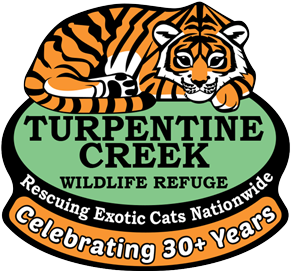Shadowing a TCWR Intern for the Day
June 18, 2021
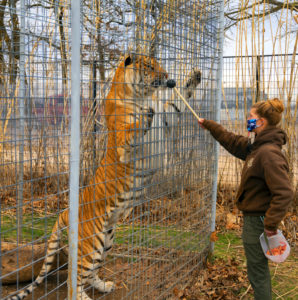 A day in the Life of an Intern is, well… hard work! As a relatively new addition to the TCWR team, I don’t recall what my preconceived notion of our intern position was, or if I even had one. But I can tell you now – I had no idea just how much hard work, how many dirty jobs, and how much dedication was required of these team members on a daily basis! Clearly, individuals in these positions are motivated by passion, determination, and a drive to serve! The daily chores of these “backbone members” of our team are a true labor of love! Just think about what it takes to look after the well-being of an animal or two, such as a dog or a cat; from feeding and watering to providing shelter and training, to obtaining medical assessment and treatments, to picking up after them, etc… It’s definitely a full-time job!
A day in the Life of an Intern is, well… hard work! As a relatively new addition to the TCWR team, I don’t recall what my preconceived notion of our intern position was, or if I even had one. But I can tell you now – I had no idea just how much hard work, how many dirty jobs, and how much dedication was required of these team members on a daily basis! Clearly, individuals in these positions are motivated by passion, determination, and a drive to serve! The daily chores of these “backbone members” of our team are a true labor of love! Just think about what it takes to look after the well-being of an animal or two, such as a dog or a cat; from feeding and watering to providing shelter and training, to obtaining medical assessment and treatments, to picking up after them, etc… It’s definitely a full-time job!
Now, multiply that by 100-fold to account for our 100+ residents currently residing at our facility! Add to the mix that these are not simple pet-level animals, but dangerous wild animals that require specialty care, individualized freshly prepared meals, medical care, assessments, behavioral training, and maintenance of highly secure housing & enclosures, designed to address the behavior and needs of the specific breed of animal. Don’t forget the high-level precautions that must also be taken, and factored in when performing any general care, maintenance, or simple routine tasks, such as movement of animals from one enclosure to another or multiple daily movements between night house and habitat! Now that you have some idea of the intense level and breadth of effort that is required to care for these amazing creatures, what exactly does that look like on a daily basis? Take a deep breath, maybe fix yourself a nice hot cup of tea or a pot of coffee (I get tired just thinking about it!) But here we go!
Our interns work from 7:00 a.m. to 4:00 p.m., or 8:00 a.m. to 5:00 p.m., six days a week, in order to achieve the high standards of care required by TCWR and governing federal and state regulators, and keep us in compliance with our GFAS accreditation. The first-morning task is always the daily cleaning of animal enclosures. But even before that can begin, policies and procedures for ensuring the safety of people and animals alike must be strictly adhered to! This means repetitive checking and double-checking of multiple levels of locks, on all outer area enclosures, inner habitat enclosures, and night house enclosures. Each lock and lock level is checked and rechecked by two different individuals, prior to, and after any routine task is performed within any of the outermost area enclosures, animal habitats, and night house enclosures.
Additionally, after all locks have been checked two times each, by two different individuals, the intern then must radio for permission from an animal care staff member, prior to passing through the access point. High-security areas, habitat enclosures, and night house areas, all boast two locks each, one paddle lock, and one fabricated rebar lock, per access point. A formal daily lock-check regiment mandates checks at 7:00 a.m., 2:00 p.m., and 4:00 p.m., and is in addition to the multiple checks performed before and after any area access for any reason. That’s a lot of locks and a lot of manpower checking locks! In fact, a good portion of every intern’s day is spent simply inspecting locks! But it’s worth it in order to ensure the safety and security of all involved.
Another major portion of an internship day is ensuring a clean, healthy environment for all our animal residents. This is where things get messy! Daily tasks include removing and relocating all animal feces, hair, and soiled bedding from each night-house, and each night-house enclosure, and transporting it to the compost area. The night-house and night-house enclosure must then be scraped to remove all feces, food, and other debris, before being thoroughly disinfected. Water & food bowls also need to be removed, scraped, and disinfected. Oftentimes during cooler weather, we augment our animals’ bedding with mulch, in order to provide additional warmth over and above the standard straw bedding. In this instance, interns are also required to sift through the bedding, to remove wet or soiled portions, and replace them with fresh ones. If an animal has a pool, (some don’t, simply because they don’t like it!) but if they do, that too, is drained and cleaned daily. The cleaning of outer habitat enclosures is rotated so that every animal’s area is fully cleared of all feces, animal hair, and any other garbage or debris, once per week.
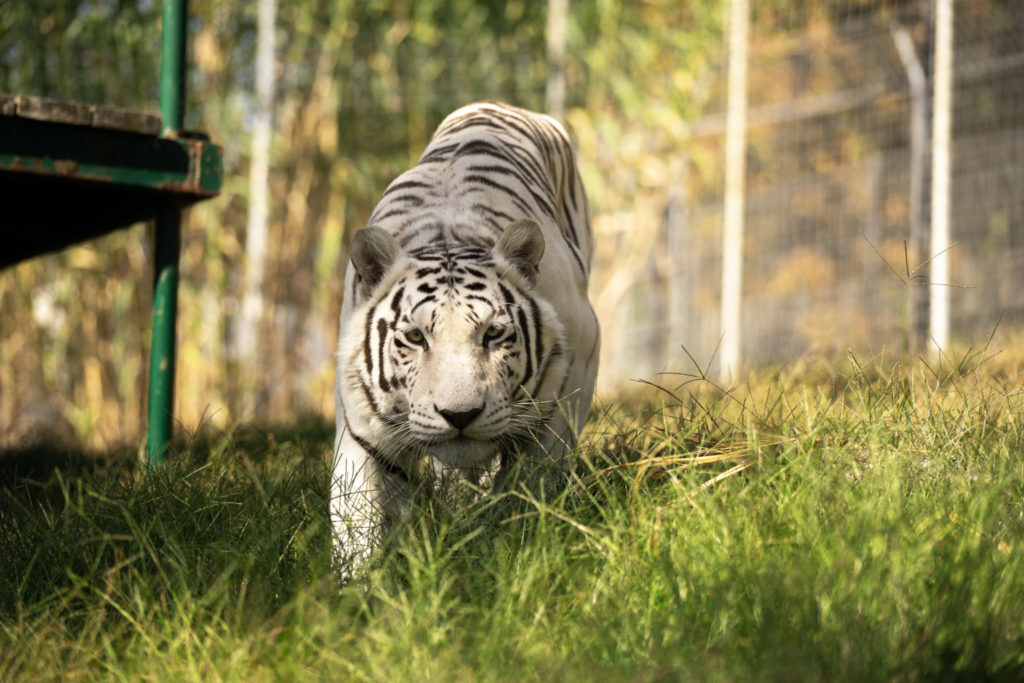
Accomplishing all these cleaning claims the remainder of the morning for our interns! Once finished, tools are washed and put up. Then one or two, two-person teams make their rounds to ensure that every habitat has all doors open that should be opened – providing animals full access to designated areas; all doors that should be closed, are closed; and all freshwater is fully topped off. During these rounds interns are also checking to verify that each individual animal appears to be in good condition; appears happy, healthy, comfortable, and without issues. Once this final morning round is complete, it’s time for a well-earned lunch break!
Upon returning, interns will fill their time with an assortment of projects such as trimming branches, weed eating, painting habitats, general maintenance, and more, until the scheduled 2:00 p.m. lock-check and then gradually segue into food preparation, until the 4:00 p.m. lock-check. Additional afternoon responsibilities include conducting the 1:00, 2:00, and 3:00 p.m. visitor tram tours, and manning the discovery area on a rotating basis to address visitor questions and monitor tour flow.
Food prep takes place in the commissary building which also houses storage areas for refrigerated, frozen, and thawing food products, as well as large open cement areas for easy cleanup (with a garden hose!) Oversized bins are used to store and transport daily servings of meat from the freezer, to the thawing room, to the meal prep site. Each portion of meat that is removed from the thawing area, is immediately replaced by an equal measurement from the freezer, ensuring a constant supply of appropriately stored and thawed meats for daily meals.
On the wall, a large whiteboard displays the dietary needs of each and every animal residing at our facility. Animal dietary needs are expressed by ink color, and specify the number of pounds of meat the animal is to receive. For example, black ink is used to communicate “bone-in” meat. Jasmine and Frankie both receive bone-in meat. A black seven appears next to their names, representing the number of pounds of the particular item they are to receive. Chuff is slated to receive 10 pounds of bone-in chicken. Next to Payson’s name we see a green 10. That means that Payson will be receiving 10 pounds of red zoological meat, also sometimes referred to as AAA, or Triple A. Frankie and Jasmine also have green numbers next to their black numbers; with each slated to receive 2 1/2 pounds of red meat. We also see blue ink, which indicates an animal preference. Perhaps an animal doesn’t have a medical condition that necessitates that they avoid a certain item, but animal care staff notices that each time it’s provided, the animal passes it up. This is an example of a food preference, that is indicated in blue ink. Another nutritional equivalent is substituted for the rejected item or meal portion. Meal portions are placed in large metal dishes with the animal name displayed on the outside. Rolling racks of these dishes line the room of the food prep area as portions are allocated. Meals are prepared one day before serving and then stored in the refrigerated area.
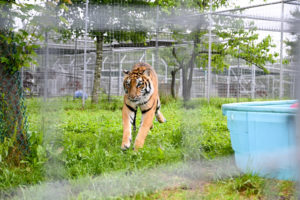
Twice a month, Emily, our animal curator, assesses each individual animal’s diet according to its health, age, weight, and caloric needs. She is constantly reassessing in order to provide maximum health and nutrition for our animals, as their needs change and evolve. Robbie, the giant white tiger who was frequently confused for a polar bear when he first arrived back in 2019, had been overfed and weighed in at a very unhealthy 700+ pounds! Through careful meal planning, Robbie’s weight is now under control, resulting in a drop of about 200 pounds, to a more natural and healthy level. His formerly restricted portions were gradually increased, to level off his weight loss, and he now gets about 14 pounds of bone-in meat per day. Currently, our highest calorie diet goes to Rockland, a female white tiger from Colorado, who is consuming 18 pounds of bone-in meat per day! Some of our animals are on special diets due to medical or age-related conditions which include additional additives to boost nutritional content or address specific deficiencies. Supplements are mixed into meals to insure consumption. Staff and interns measure, prepare, and feed approximately 16,000+ pounds of meat per month, on average that’s about 525 pounds of meat per day, or 300,000 pounds of meat annually!
Unlike the big cats, who are fed once a day, our bears are fed twice, except in winter months when they’re significantly less active. As omnivores, whose wild diet consists of approximately 80% produce, our bears are fed an assortment of fresh fruits, veggies, and other items aside from meat. A routine diet prepared for them may include chicken, sweet potatoes, oranges, apples, oats, dog food, and canned foods such as pumpkin, peas, corn, peaches, and pears! In addition to their 2 meals per day, they get an egg (shell and all!) plus a “fun” dish which includes some sweet or savory items to offer additional texture and variety and add quality of life!
Prior to feeding, the commissary and all food prep equipment are scrubbed clean, disinfected, and readied for the next days’ shift. Next, each animal must be relocated to and secured within their innermost habitat area prior to feeding (while staff and interns adhere to all previously detailed 2 person lock-check and safety procedures). Interns are accompanied by staff members as they make their way around the tour loop, feeding, immediately after completion of the final daily tour.
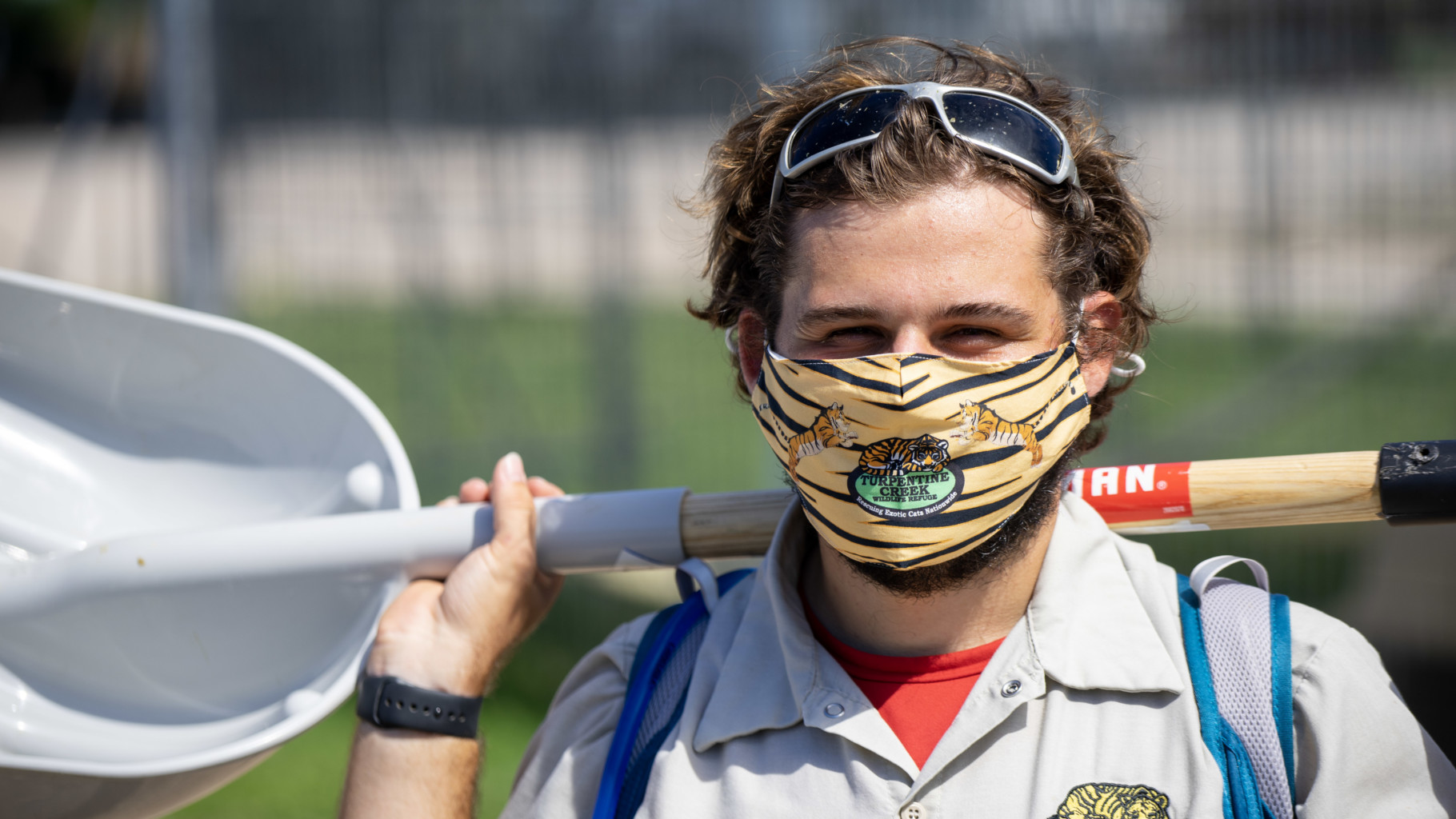
TCWR offers post-graduate internships for 6 months after a degree has been obtained. The degree should be in animal-based science, such as biology, zoology, animal science, conservation, etc., or geared toward biology and animal science. Interested individuals can find more information at: https://www.turpentinecreek.org/internship-program/.
###
Our contributing intern interviewed for this article was Jason Lavanway. Jason was an intern at Turpentine Creek Wildlife Refuge for 2 1/2 years, prior to his promotion to staff in January 2021. He is originally from North East New York and graduated with a BS in Zoology (animal science).
